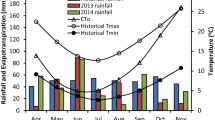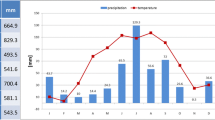Abstract
The paper demonstrates how standard climatological data can effectively be exploited by making use of biometeorological knowledge and modern data processing facilities in studies concerned with the evaluation of crop-weather relationships and the analysis of climatic resources. In analyzing potential biological yield of wheat at Normandin (Quebec), it was found that the potential yield was reduced by approximately 45% because of variations in temperature and radiation whereas the actual yield was reduced by 70%. In mesoscale analyses, the error between soil moisture observations and estimates from a climatological soil moisture budget was in the same order as the standard deviation of 3-times replicated 38 soil moisture samples taken over five years at Swift Current (Sask.). An analysis of crop-weather relationships at Lacombe (Alta.) indicated that the 1957 wheat yield was reduced from the potential 3,300 kg/ha to 2,004 kg/ha or by 40% because of a severe cold spell during the soft dough developing stage resulting in improper filling of the kernels. In macroscale analyses, relative winter hardiness indices for woody ornamental plants together with site suitability indices for winter survival were used in the development of a map of plant hardiness zones in Canada. In the application of this research to forage crops average winter survival percentage of legumes and grasses by classes of hardiness together with selected regional climatic averages were developed for six regions of southern Canada. Long-term research into the relationships between Canadian Prairie crop yields and development (wheat, oats and barley) and selected climatic and soil variables has been used successfully for estimating regional crop production, for determining climatic limitations of the area suitable for the cultivation of these crops, and for assessing the impact of postulated climatic changes on crop production.
Similar content being viewed by others
References
AGRICULTURE CANADA: Research Branch Report (annually) Information Canada, Ottawa.
BAIER, W. and ROBERTSON, G.W. (1965): Estimation of latent evaporation from simple weather observations. Canad. J. Plant Sci., 45: 276–284.
BAIER, W. and ROBERTSON, G.W. (1966): A new versatile soil moisture budget. Canad. J. Plant Sci., 46: 299–315.
BAIER, W. and ROBERTSON, G.W. (1968): The performance of soil moisture estimates as compared with the direct use of climatological data for estimating crop yields. Agric. Meteor., 5: 17–31.
BAIER, W. (1971/72): An agroclimatic probability study of the economics of fallow-seeded and continuous spring wheat in southern Saskatchewan. Agric. Meteor., 9: 305–321.
BAIER, W. CHAPUT, D., RUSSELO, D. and SHARP, R. (1972): Soil moisture estimator program system. Tech.Bull. No 78, Agrometeorological Section, Plant Research Institute, Canada Dept. of Agriculture, Ottawa. 55 pp.
BAIER, W. (1973a): Crop-weather analysis model. 1. Summary Int. J. Biometeor., 17: 313–320.
BAIER, W. (1973b): Crop-weather analysis model. Review and model development. J. appl. Meteor., 12: 937–947.
BAIER, W. and WILLIAMS, G.D.V. (1974): Regional wheat yield predictions from weather data in Canada. In: Agrometeorology of the wheat crop, Proceedings of the WMO Symposium, Braunschweig, Federal Republic of Germany, Oct. 1973. Wrld.Meteor.Org., No 396, 265–283.
DE WIT, C.T. (1965): Photosynthesis of leaf canopies. Agric.Res. Rep. Centre Agric. Publ. Docum., Wageningen, 633: 1–57.
DUNCAN, W.G., LOOMIS, R.S., WILLIAMS, W.A. and HANAU, R. (1967): A model for simulating photosynthesis in plant communities. Hilgardia, 38: 181–205.
FRIEND, D.J.C., HELSON, V.A. and FISHER, J.E. (1965): Changes in the leaf area ratio during growth of Marquis wheat, as affected by temperature and light intensity. Canad. J. Bot., 43: 15–28.
HAYHOE, H.N. and JACKSON, L.P. (1974): Weather effects on hay drying rates. Canad. J. Plant Sci., 54: 479–484.
MONTEITH, J.L. (1973): Principles of Environmental Physics. Edward Arnold Ltd., London, 241 pp.
OUELLET, C.E. and SHERK, L. (1967a): Map of plant hardiness zones in Canada. Canad. Dept. Agric. Pub.
OUELLET, C.E. and SHERK, L. (1967b): Woody ornamental zonation. I. Indices of hardiness. Canad. J. Plant Sci., 47: 231–239.
OUELLET, C.E. and SHERK, L. (1967c): Woody ornamental plant zonation. II. Suitability indices of localities. Canad. J. Plant Sci., 47: 339–349.
OUELLET, C.E. and SHERK, L. (1967d): Woody ornamental plant zonation. III. Suitability map for the probable winter survival of ornamental trees and shrubs. Canad. J. Plant Sci., 47: 351–358.
OUELLET, C.E. (1973): Macroclimatic model for estimating monthly soil temperatures under short-grass cover in Canada. Canad. J. Soil Sci., 53: 263–274.
ROBERTSON, G.W. (1968): A biometeorological time scale for a cereal crop involving day and night temperatures and photoperiod. Int. J. Biometeor., 12: 191–223.
SUSUKI, M. (1972): Winterkill patterns of forage crops and winter wheat in P.E.I. in 1972. Canad. Plant Dis. Surv., 52: 156–159.
WILLIAMS, G.D.V. and SHARP, W.R. (1967): A program to estimate normals of temperature and related agroclimatic elements for locations on the Canadian Great Plains. Tech.Bull. No 11, Agrometeorology Section, Plant Research Institute. Canada Dept. Agriculture, Ottawa, 27 pp.
WILLIAMS, G.D.V. (1969): Applying estimated temperature normals to the zonation of the Canadian Great Plains for wheat. Canad. J. Soil Sci., 49: 263–276.
WILLIAMS, G.D.V. (1971): Physical resources for barley production on the Canadian Great Plains. M.A. Thesis, Dept. of Geography, Carleton University, Ottawa, Ontario, 228 pp.
WILLIAMS, G.D.V. (1974a): Physical frontiers of crops: the example for growing barley to maturity in Canada. In: Frontier Settlement, University of Alberta, Studies in Geography, Monograph 1. Eds. R.G.Ironside, V.B.Proudfoot, E.N.Shannon and C.J.Tracie. 79–92.
WILLIAMS, G.D.V. (1974b): Deriving a biophotothermal time scale for barley. Int. J. Biometeor., 18: 57–69.
WILLIAMS, G.D.V. (1974c): A critical evaluation of a biophotothermal time scale for barley. Int. J. Biometeor., 18: 259–271.
WILLIAMS, G.D.V., JOYNT, M.I. and McCORMICK, P.A. (1975): Regression analyses of Canadian Prairie crop district cereal yields, 1961–72, in relation to weather, soil and trend. Canad. J. Soil Sci., 55: 43–53.
Author information
Authors and Affiliations
Additional information
Contribution No 862 of the Chemistry and Biology Research Institute.
Rights and permissions
About this article
Cite this article
Baier, W., Davidson, H., Desjardins, R.L. et al. Recent biometeorological applications to crops. Int J Biometeorol 20, 108–127 (1976). https://doi.org/10.1007/BF01553045
Received:
Issue Date:
DOI: https://doi.org/10.1007/BF01553045




